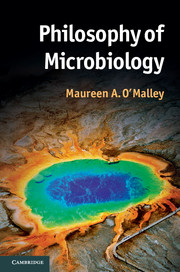Book contents
- Frontmatter
- Contents
- List of figures and tables
- Acknowledgements
- An introduction to philosophy of microbiology
- Chapter 1 Philosophy in microbiology; microbes in philosophy
- Chapter 2 Philosophical debates in high-level microbial classification
- Chapter 3 Philosophical debates in species-level microbial classification
- Chapter 4 Philosophical issues in microbial evolution
- Chapter 5 Microbial ecology from a philosophical perspective
- Chapter 6 Microbes as model biological systems
- Conclusion: further philosophical questions
- Glossary
- References
- Index
Chapter 2 - Philosophical debates in high-level microbial classification
Published online by Cambridge University Press: 05 September 2014
- Frontmatter
- Contents
- List of figures and tables
- Acknowledgements
- An introduction to philosophy of microbiology
- Chapter 1 Philosophy in microbiology; microbes in philosophy
- Chapter 2 Philosophical debates in high-level microbial classification
- Chapter 3 Philosophical debates in species-level microbial classification
- Chapter 4 Philosophical issues in microbial evolution
- Chapter 5 Microbial ecology from a philosophical perspective
- Chapter 6 Microbes as model biological systems
- Conclusion: further philosophical questions
- Glossary
- References
- Index
Summary
This chapter will examine a range of the classificatory practices used to order the microbial world. Some of the categories in hierarchical classification are understood as ‘real’ and others not. Microbiology’s quest for a natural classification system has usually been thought about in regard to species. However, other levels in the ‘grand hierarchy of life’, such as kingdoms and domains, are just as problematic. I will examine several of these higher-level debates and conclude with their implications for classification in general.
Microbes versus macrobes; pragmatic versus natural classification
This book is about a vaguely defined type of life form: the microorganism. The label ‘microbe’ or ‘microorganism’ is used to describe any organism too small to be seen without a microscope. Conventionally, this category includes bacteria, archaea (which also used to be called bacteria), protists and many fungi. Microbiology textbooks usually include viruses and virology within the remit of microbiology (e.g., Madigan et al. 2008), although many microbiologists and virologists do not count viruses as microbes (e.g., van Regenmortel 2011). Although microscopic size is an undeniably important feature of microorganismal life, it is also a very problematic criterion. Many of these supposedly microscopic organisms are quite visible to the naked eye, due to their habit of clustering together in large, sometimes colourful, single-taxon colonies (for example, moulds and filaments) or ubiquitous multitaxon biofilms (slimy accretions of microbes). There are even some bacteria that are visible as single cells. One of these is the spherical sulphur bacterium, Thiomargarita namibiensis, which is found in seafloor sediments off the coast of Namibia. It can have a diameter of up to 750 μm (1000 μm = 1mm) and now tops the growing list of giant bacteria, all of which have enormous amounts of DNA due to genome duplication (Angert 2012).
- Type
- Chapter
- Information
- Philosophy of Microbiology , pp. 45 - 64Publisher: Cambridge University PressPrint publication year: 2014



